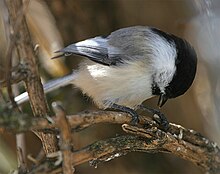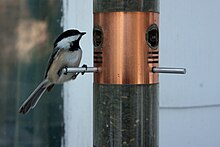The black-capped chickadee (Poecile atricapillus) is a small, nonmigratory, North American songbird that lives in deciduous and mixed forests. It is a passerine bird in the tit family Paridae. It is the state bird of both Maine and Massachusetts in the United States, and the provincial bird of New Brunswick in Canada. It is well known for its capacity to lower its body temperature during cold winter nights as well as its good spatial memory to relocate the caches where it stores food, and its boldness near humans (sometimes feeding from the hand).
Taxonomy
Though often placed in the genus Parus with most other tits, mtDNA cytochrome b sequence data and morphology suggest that separating Poecile more adequately expresses these birds' relationships.[2] The American Ornithologists' Union has treated Poecile as a distinct genus for some time.
The genus name Poecile has often been treated as feminine (giving the species name ending atricapilla); however, this was not specified by the original genus author Johann Jakob Kaup, and under the ICZN, the genus name must therefore be treated by default as masculine, giving the name ending atricapillus.[3]
At one time the black-capped chickadee was considered by some to be conspecific with the willow tit of Eurasia, due to their very similar appearance. This is reflected in an older version of the Peterson Field Guide for the Birds of Britain and Europe, which states "N Am. Black-Capped Chickadee" as an alternate name for the willow tit. In fact the willow tit, black-capped chickadee, marsh tit and Carolina chickadee are all very similar to one another in appearance.
Description
The black-capped chickadee has a black cap and "bib" with white sides to the face. Its underparts are white with rusty brown on the flanks. Its back is gray and the tail is normally slate-gray. This bird has a short dark bill of 8–9.5 mm (0.31–0.37 in), short rounded wings 63.5–67.5 mm (2.50–2.66 in), a tarsus of 16–17 mm (0.63–0.67 in) and a long tail at 58–63 mm (2.3–2.5 in).[4] Total body length is 12–15 cm (4.7–5.9 in), wingspan is 16–21 cm (6.3–8.3 in) and body mass is 9–14 g (0.32–0.49 oz).[5] Sexes look alike, but males are slightly larger and longer than females.
Although range can generally be used to separate them, the black-capped chickadee is very similar in appearance to the Carolina chickadee. The black-capped is larger on average but this cannot be used reliably for identification. The most obvious difference between the two is in the wing feathers. In the black-capped chickadee, the wing feathers have white edges that are larger and more conspicuous than those of the Carolina chickadee. The latter is often mistaken for black-capped chickadees with feather dystrophy which sometimes affects the appearance of the primary feathers making them look slimmer, a phenomenon caused by illnesses such as fatty liver disease in malnourished birds. Overall, the Carolina appears slightly paler colored whereas the flanks of the black-capped can appear to have a trace of off-yellow or rusty coloration. Also, the black-capped generally has a more "ragged" looking black bib, whereas the bib of the Carolina has a more smooth-edged look. These subtle features are often even more vague in populations around where the black-capped and Carolina overlap in range (possibly the result of hybrids) and the two cannot always be distinguished as two species. The two species were formerly thought to be easily distinguished by call, but they often learn each other's vocalizations where their ranges overlap (their point of overlap is a narrow band that runs along the east-central United States, with the black-capped chickadee to the north). A bird located near the zone of overlap that sings both songs, or sings "odd-sounding" songs, cannot be positively identified solely by voice in the field.[6]
Ecology
Diet and foraging
Insects (especially caterpillars) form a large part of their diet in summer. The birds hop along tree branches searching for food, sometimes hanging upside down or hovering; they may make short flights to catch insects in the air. Seeds and berries become more important in winter, though insect eggs and pupae remain on the menu. Black oil sunflower seeds are readily taken from bird feeders. The birds take a seed in their bill and commonly fly from the feeder to a tree, where they proceed to hammer the seed on a branch to open it.
Like many other species in the Paridae family, black-capped chickadees commonly cache food, mostly seeds but sometimes insects also.[7] Items are stored singly in various sites such as bark, dead leaves, clusters of conifer needles, or knothole. Memory for the location of caches can last up to 28 days.[8] Within the first 24 hours, the birds can even remember the relative quality of the stored items.[9]
At bird feeders, black-capped chickadees tolerate human approach to a much greater degree than other species do. In fact, during the winter, many individuals accustomed to human habitation will readily accept seed from a person's hand.
Metabolism
On cold winter nights, these birds can reduce their body temperature by as much as 10 to 12 °C (from their normal temperature of about 42 °C) to conserve energy.[10][11] Such a capacity for torpor is not very common in birds. Other bird species capable of torpor include the common swift Apus apus, the common poor-will Phalaenoptilus nuttallii, the lesser nighthawk Chordeiles acutipennis, and various species of hummingbirds.
Movements
These birds are permanent residents, but sometimes they move south within their range, and even outside of it, in the fall or winter.
During the winter, chickadees often flock together. Many other species of birds – including titmice, nuthatches, and warblers – can often be found foraging in these flocks. Mixed flocks stay together because the chickadees call out whenever they find a good source of food. This calling-out forms cohesion for the group, allowing the other birds to find food more efficiently. When flocking, black-capped chickadees soon establish a rigid social hierarchy. In such hierarchies, males usually rank over females, and older birds over juveniles.
Black-capped chickadees sleep in thick vegetation or in cavities, usually singly, though there have been suggestions that they may occasionally roost clumped together.[12] The sleeping posture is with the bill tucked under the scapular (shoulder) feathers.
Their flight is slightly undulating with rapid wing beats. Flight speed is about 20 km/h (12 mph).




No comments:
Post a Comment